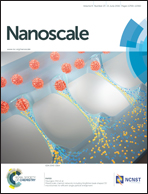Effects of para-substituents of styrene derivatives on their chemical reactivity on platinum nanoparticle surfaces†
Abstract
Stable platinum nanoparticles were successfully prepared by the self-assembly of para-substituted styrene derivatives onto the platinum surfaces as a result of platinum-catalyzed dehydrogenation and transformation of the vinyl groups to the acetylene ones, forming platinum–vinylidene/–acetylide interfacial bonds. Transmission electron microscopic measurements showed that the nanoparticles were well dispersed without apparent aggregation, suggesting sufficient protection of the nanoparticles by the organic capping ligands, and the average core diameter was estimated to be 2.0 ± 0.3 nm, 1.3 ± 0.2 nm, and 1.1 ± 0.2 nm for the nanoparticles capped with 4-tert-butylstyrene, 4-methoxystyrene, and 4-(trifluoromethyl)styrene, respectively, as a result of the decreasing rate of dehydrogenation with the increasing Taft (polar) constant of the para-substituents. Importantly, the resulting nanoparticles exhibited unique photoluminescence, where an increase of the Hammett constant of the para-substituents corresponded to a blue-shift of the photoluminescence emission, suggesting an enlargement of the HOMO–LUMO band gap of the nanoparticle-bound acetylene moieties. Furthermore, the resulting nanoparticles exhibited apparent electrocatalytic activity towards oxygen reduction in acidic media, with the best performance among the series of samples observed with the 4-tert-butylstyrene-capped nanoparticles due to an optimal combination of the nanoparticle core size and ligand effects on the bonding interactions between platinum and oxygen species.


 Please wait while we load your content...
Please wait while we load your content...